
This task provides students practice with flawed reasoning using fraction comparisons.
- Subject:
- Education
- Elementary Education
- Mathematics
- Material Type:
- Activity/Lab
- Assessment
- Homework/Assignment
- Date Added:
- 08/15/2018

This task provides students practice with flawed reasoning using fraction comparisons.
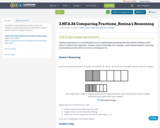
This flawed reasoning task provides practice for students to understand the size of the wholes must be equal in order to compare fractions.
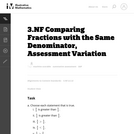
This is a task from the Illustrative Mathematics website that is one part of a complete illustration of the standard to which it is aligned. Each task has at least one solution and some commentary that addresses important asects of the task and its potential use. Here are the first few lines of the commentary for this task: Choose each statement that is true. $\frac34$ is greater than $\frac54$. $\frac54$ is greater than $\frac34$. $\frac34 \gt \frac54$. $\frac34 \lt \frac...
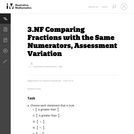
This is a task from the Illustrative Mathematics website that is one part of a complete illustration of the standard to which it is aligned. Each task has at least one solution and some commentary that addresses important asects of the task and its potential use. Here are the first few lines of the commentary for this task: Choose each statement that is true. $\frac98$ is greater than $\frac{9}{4}$. $\frac{9}{4}$ is greater than $\frac98$. $\frac98 \gt \frac{9}{4}$. $\frac...
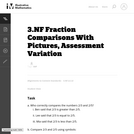
This is a task from the Illustrative Mathematics website that is one part of a complete illustration of the standard to which it is aligned. Each task has at least one solution and some commentary that addresses important asects of the task and its potential use. Here are the first few lines of the commentary for this task: Who correctly compares the numbers 2/3 and 2/5? Ben said that 2/3 is greater than 2/5. Lee said that 2/3 is equal to 2/5. Mia said that 2/3 is less tha...
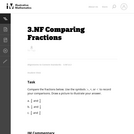
The purpose of this task is for students to compare fractions using common numerators and common denominators and to recognize equivalent fractions.

This task is meant to address a common error that students make, namely, that they represent fractions with different wholes when they need to compare them. This task is meant to generate classroom discussion related to comparing fractions. Particularly important is that students understand that when you compare fractions, you implicitly always have the same whole.
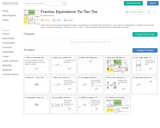
Show what you know about equivalent fractions and ordering by choosing three activities (in a row, column, or diagonal) to complete the tic-tac-toe board. Standards assessed: 3.NF.3a-d, 4.NF.1, 4.NF.2. This assessment was designed for adult basic education.
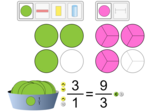
Build equivalent fractions with different denominators. Match shapes and numbers to earn stars in the game. Challenge yourself on any level you like. Try to collect lots of stars!